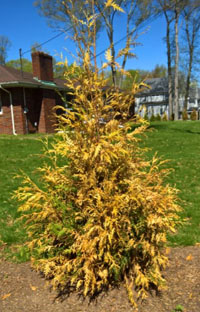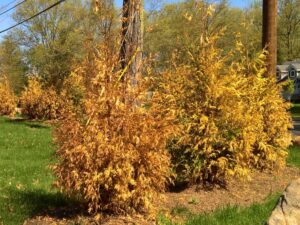
Arborvitae and Green Giant Arborvitae that are all white, tan or brown all have winter damage on them. These plants will not recover. This is the result of the milder temperatures we had earlier in the winter when the temps went from mild to cool to warm to cold. The plants started to break dormancy thinking it was springtime. Then we had the cold and bitter temperatures set in. The results were plants that were not ready for the extreme cold temperatures while thinking it was time to start growing for the spring. They will need to be replaced.

Arbs with brown tips or branches on an otherwise healthy looking plant is simply branches that were broken while being dug at the nursery, being wrapped tight to be shipped and from handling while being loaded and unloaded from trucks. These can simply be clipped off with hand pruners as they are unsightly but not a problem with the plant.
Winter Burn on Rhododendrons
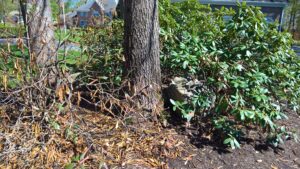
Over the last couple of weeks, there have been many reports of damaged rhododendrons. The most likely explanation for this phenomenon is winter burn injury but that is not the root of the problem.
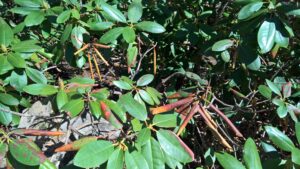
The rhododendrons have Leaf Spot which is a fungus and Dieback which is also a fungus. Pruning of diseased branches, preventing the plant from drying out and keeping them fed will promote their health. The disease can spread or it can stay put on a few plants – we have seen this go both ways. It stops in its tracks or it eventually moves to the other plants. There is no treatment to stop the fungus.
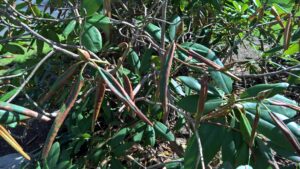
Check out additional information about the disease.
Botryosphaeria Dieback (Botryosphaeria dothidea)
This is the most common disease of rhododendron in the landscape. A typical symptom of this fungal disease is scattered dying branches on an otherwise healthy plant. Leaves on infected stems turn brown, then droop and roll inward. These leaves often lay flat against the stem and will remain attached. The pathogen can infect all ages of stem tissue through wounds, pruning cuts, and leaf scars. Heat, drought stress, and winter injury can increase disease incidence. Cankers on branches can gradually grow through the wood until the stem becomes girdled. Diseased wood is reddish brown in appearance. Discolored wood viewed in longitudinal cross section often forms a wedge that points toward the center of the stem, and the pith may be darker brown than the surrounding wood.
Management: Fungicide treatments are not an effective disease control option. Plants should be grown in partial shade, with mulch and kept well-watered during dry periods. All dying branches should be promptly pruned out in dry weather and all discolored wood should be removed. Plants should also be protected from rough treatment during maintenance activities to prevent unnecessary wounds.
 We found this at the base of one of the plants – actually a herd of them! They appear to be termites in the center bush. The plant had been dead for a while, probably where the disease originated from. Therefore it has rotted wood at its base that the termites found. In this case, you might want to check your property (and your neighbors) as they came from and are headed somewhere
We found this at the base of one of the plants – actually a herd of them! They appear to be termites in the center bush. The plant had been dead for a while, probably where the disease originated from. Therefore it has rotted wood at its base that the termites found. In this case, you might want to check your property (and your neighbors) as they came from and are headed somewhere

